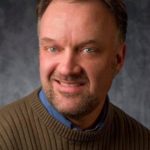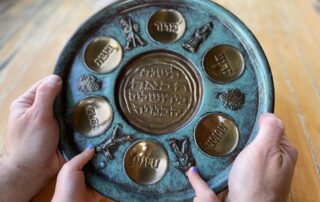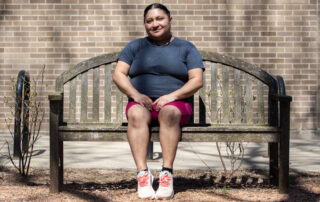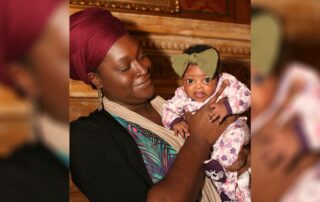Wisconsin has always been a beacon of German culture. Now, it is undergoing a renaissance at the University of Wisconsin-Oshkosh. Walk across campus with Professors Heike Alberts and Monika Hohbein-Deegen and you will likely hear a conversation in German. Both professors started on campus in 2003, on the very same day. While both are German, their paths to Oshkosh were very different.
Professor Alberts pulls out an aerial map of Berlin and pinpoints where she grew up in the Frohnau neighborhood. It’s on the northern outskirts of Berlin and at the time of the Cold War was surrounded on three sides by the Berlin Wall. Professor Alberts says, “I always thought that all cities had walls. It was absolutely normal for me. I did not know life without a wall.” Professor Hohbein-Deegen grew up in East Germany in the little village of GrossBruechter. Her childhood home is in the German state of Thuringia and relatively close to the inner German border dividing East and West Germany.
On November 9, 2019, a unified Germany celebrated the 30th anniversary of the peaceful revolution that toppled the Berlin Wall. Around this occasion, the professors shared what life was like growing up on opposite sides of the wall. Professor Hohbein-Deegen lived under a dictatorship in Communist East Germany. “Sometimes I try to tell my students what this life was like. Yes, on one hand, we were very restricted. On the other hand, it was a normal upbringing. This is a little bit difficult to balance that because you don’t want to paint it too black or too rosy. It was something in between.”
Professor Alberts also describes what to her was a very normal life with western freedoms in a democracy, even if her backyard was at the foot of the Berlin Wall. During her childhood, she remembers nighttime never being dark because the flood lights along the border would light up the night sky. She was also close enough to the wall to sometimes hear shouting, sirens and even gunfire. It wasn’t until a couple of years ago that she learned her Frohnau neighborhood was also the site of tunnels East Germans had dug under the wall to escape. She describes one as a “senior citizen tunnel” – built tall enough so the older generation could walk thru it upright and hold their heads high as they left the Communist East.
Both professors now teach about a wall they themselves never learned about in school. On trips to Germany, Professor Hohbein-Deegen teaches her Oshkosh students about World War II Germany, the Cold War and East Germany history. Professor Alberts teaches them human geography. They visit the historic sites like Checkpoint Charlie, the Bernauer Strasse Wall Memorial, and the Topography of Terror, site of the former Gestapo Headquarters. The professors help their students to take off their American hats and see things through the eyes of other people and to learn from history.
The students discover back in 1989 the East German people took to the streets as the world watched the fall of the Berlin Wall live on television. Professors Alberts and Hohbein-Deegen both slept through it and only heard the news the next morning. The days that followed became an adventure for these future Wisconsinites. Heike Alberts was 17 years old at the time and went with a friend to take pictures of the wall. One of her favorite photographs is of her dad chipping away at the wall to break off a piece of history. Her high school band marked the occasion by marching across the border into East Germany. “I was always in the first row and remember they had just cleared the death zone of all the nasty equipment. But this was also the first time I really set foot on the death zone that had killed so many people before that. ”
Monika Hohbein-Deegen was 20 years old when the wall fell and her experience going East to West was a bit different. While she studied English in school, she never thought she would be able to visit an English-speaking country. When Communism collapsed, she had her opportunity and traveled to the United States on a scholarship. “I never forget when I actually came to America the very first time. It was rather amazing because I was thinking, ‘OK, this was the enemy country I was taught about and now I’m here.’”
Before coming to Wisconsin, she made a Green Bay Packers connection while teaching at the University of Southern Mississippi. “I remember people pointed out, by the way, you have Brett Favre in your courses. I said, ‘Who is he?’ Well, coming from Germany, football is not really popular. Now, you know, I wish I would have kept his exams or something like that?”
Both professors now feel at home in Wisconsin following in the footsteps of other German immigrants. Professor Alberts says, “A lot of students say, ‘Oh, the German. Right. I had a class with the German.’ So, I think, if anything, my German identity has become much stronger by not being in Germany. I mean, now it’s in demand that I speak about those kinds of things.”
Professor Hohbein-Deegen reflects on the timing and aftermath of German Reunification. “I am very glad it happened the time it did, because I was 20 years old when the wall fell. So, on one hand, I was old enough to have all of the memories. I remember everything, but I was also young enough to take advantage of it. Whereas the older generation for them, it was probably very difficult to do so. If you’re in your 50s, you lost your job. You have to retrain. You have to learn computer skills. That’s difficult, you know. So, I think I was just the right age.”
Living through the experience allows Alberts and Hohbein-Deegen to look back and share their personal stories.
Brett Favre in Class
As a German Language teacher at the University of Southern Mississippi, Monika Hohbein-Deegen had the famous quarterback in her class.
Winners and Losers: German Reunification
Not everyone benefited from German Reunification. Take a listen to University of Wisconsin-Oshkosh Professor Monika Hohbein-Deegen’s perspective.
Related Links for this Article
Chronicle of the Berlin Wall website
The History of Bernauer Strasse on the Berlin Wall Memorial website










